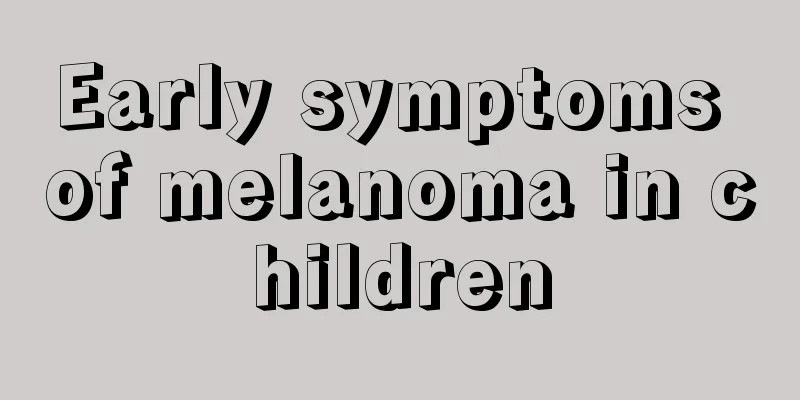Early symptoms of melanoma in children

|
Early symptoms of melanoma in children include irregular black or brown spots on the skin, changes in the color or size of the mole, blurred or asymmetrical mole edges, etc. Early detection and timely medical treatment are the key, and treatment methods include surgical excision, targeted therapy, and immunotherapy. 1. Genetic factors Melanoma may be related to heredity, and children with a family history of melanoma have a higher risk of the disease. Gene mutations such as abnormalities in the CDKN2A or BRAF genes may increase the probability of disease. Families with a family history are advised to take their children for regular skin examinations, especially to observe changes in moles. 2. Environmental factors Long-term exposure to ultraviolet rays is an important cause of melanoma. Children have delicate skin and are more susceptible to ultraviolet damage. Parents should take sun protection measures for their children, such as using sunscreen, wearing sun hats and clothing, and avoiding long-term outdoor activities during periods of strong sunlight. 3. Physiological factors Children's immune systems are not fully developed yet, so they may have a weaker ability to eliminate abnormal cells, increasing the risk of melanoma. Maintaining a healthy lifestyle, such as a balanced diet and regular exercise, can help enhance immunity. 4. Trauma Repeated friction or damage to the skin may induce melanoma. Parents should take care to protect their children's skin and avoid prolonged friction or pressure on certain parts, especially areas with existing moles. 5. Pathological factors Melanoma may develop from a benign mole that has become malignant. If you find that your child's mole has uneven color, irregular edges, increased diameter, or is accompanied by symptoms such as itching or bleeding, you should seek medical attention immediately. Early diagnosis can be confirmed through dermoscopy or biopsy. Treatment: Surgical resection: For early melanoma, surgical resection is the preferred method. Complete removal of the lesion can effectively prevent its spread. Targeted therapy: Drugs that target specific gene mutations, such as BRAF inhibitors, can inhibit tumor growth. Immunotherapy: Treatment that activates the immune system to attack cancer cells, such as PD-1 inhibitors, is suitable for advanced or recurrent melanoma. Prevention and care: Diet: Eating more foods rich in antioxidants, such as dark-colored vegetables and fruits, can help protect skin health. Exercise: Moderate exercise can promote blood circulation and enhance immunity, but avoid excessive sun exposure. The early symptoms of melanoma in children should not be ignored. Parents should pay close attention to their children's skin changes and seek medical treatment in time. Through scientific treatment and prevention measures, the risk of melanoma can be effectively reduced and the health of children can be protected. |
<<: How long after teratoma surgery can I drink water
>>: How long can a 70-year-old with advanced lung cancer live without treatment
Recommend
Symptoms of lobular lung cancer
Symptoms of lobular lung cancer? Lobular pneumoni...
Early pictures of breast cancer
Breast cancer is a malignant disease that serious...
The role of adenoids in the human body
The adenoids are located in a relatively hidden p...
Why do fingernails break easily?
Hands are a very important part of our body. With...
How to make corn dumplings
The taste and nutritional value of corn are outst...
How can I not get pregnant without contraception
We all know that pregnancy is not a one-person th...
The best Chinese medicine hospital for treating bone cancer
Where is the best Chinese medicine hospital for t...
Why does moldy food cause liver cancer? Liver cancer patients should not eat too much of these foods
Many middle-aged people are about 40 years old. T...
Why does a mentally ill person's jaw keep moving
Psychiatric patients suffer from schizophrenia or...
Is the blood mark on the inner thigh AIDS?
Blood marks on the inner thighs may not necessari...
How to diagnose gastroesophageal reflux
Gastroesophageal reflux is a disease with a relat...
Clinical manifestations of teratoma
Teratoma is a very small tumor that does not caus...
My elbows itch in the summer
Elbows become itchy in the summer. This is probab...
What's wrong with toothache and eye pain
Toothache and eye pain are both common clinical p...
Will endometrial cancer stage 1A usually recur? Usually not
Endometrial cancer stage 1A generally does not re...









